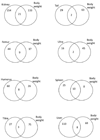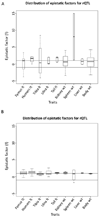Evolution of pleiotropy: epistatic interaction pattern supports a mechanistic model underlying variation in genotype-phenotype map
- PMID: 21462316
- PMCID: PMC3112255
- DOI: 10.1002/jez.b.21410
Evolution of pleiotropy: epistatic interaction pattern supports a mechanistic model underlying variation in genotype-phenotype map
Abstract
The genotype-phenotype (GP) map consists of developmental and physiological mechanisms mapping genetic onto phenotypic variation. It determines the distribution of heritable phenotypic variance on which selection can act. Comparative studies of morphology as well as of gene regulatory networks show that the GP map itself evolves, yet little is known about the actual evolutionary mechanisms involved. The study of such mechanisms requires exploring the variation in GP maps at the population level, which presently is easier to quantify by statistical genetic methods rather than by regulatory network structures. We focus on the evolution of pleiotropy, a major structural aspect of the GP map. Pleiotropic genes affect multiple traits and underlie genetic covariance between traits, often causing evolutionary constraints. Previous quantitative genetic studies have demonstrated population-level variation in pleiotropy in the form of loci, at which genotypes differ in the genetic covariation between traits. This variation can potentially fuel evolution of the GP map under selection and/or drift. Here, we propose a developmental mechanism underlying population genetic variation in covariance and test its predictions. Specifically, the mechanism predicts that the loci identified as responsible for genetic variation in pleiotropy are involved in trait-specific epistatic interactions. We test this prediction for loci affecting allometric relationships between traits in an advanced intercross between inbred mouse strains. The results consistently support the prediction. We further find a high degree of sign epistasis in these interactions, which we interpret as an indication of adaptive gene complexes within the diverged parental lines.
Copyright © 2011 Wiley-Liss, Inc., A Wiley Company.
Figures




Similar articles
-
Epistasis and Pleiotropy Affect the Modularity of the Genotype-Phenotype Map of Cross-Resistance in HIV-1.Mol Biol Evol. 2016 Dec;33(12):3213-3225. doi: 10.1093/molbev/msw206. Epub 2016 Sep 27. Mol Biol Evol. 2016. PMID: 27678053 Free PMC article.
-
Epistatic pleiotropy and the genetic architecture of covariation within early and late-developing skull trait complexes in mice.Genetics. 2005 Oct;171(2):683-94. doi: 10.1534/genetics.104.038885. Epub 2005 Jul 14. Genetics. 2005. PMID: 16020793 Free PMC article.
-
Genetic variation in pleiotropy: differential epistasis as a source of variation in the allometric relationship between long bone lengths and body weight.Evolution. 2008 Jan;62(1):199-213. doi: 10.1111/j.1558-5646.2007.00255.x. Epub 2007 Nov 12. Evolution. 2008. PMID: 18005158
-
Epistasis and pleiotropy-induced variation for plant breeding.Plant Biotechnol J. 2024 Oct;22(10):2788-2807. doi: 10.1111/pbi.14405. Epub 2024 Jun 14. Plant Biotechnol J. 2024. PMID: 38875130 Free PMC article. Review.
-
The relationship between development and evolution through heritable variation.Novartis Found Symp. 2007;284:55-65; discussion 65-70, 110-5. doi: 10.1002/9780470319390.ch4. Novartis Found Symp. 2007. PMID: 17710847 Review.
Cited by
-
Epistasis and Pleiotropy Affect the Modularity of the Genotype-Phenotype Map of Cross-Resistance in HIV-1.Mol Biol Evol. 2016 Dec;33(12):3213-3225. doi: 10.1093/molbev/msw206. Epub 2016 Sep 27. Mol Biol Evol. 2016. PMID: 27678053 Free PMC article.
-
Genome-wide association study for variants that modulate relationships between cerebrospinal fluid amyloid-beta 42, tau, and p-tau levels.Alzheimers Res Ther. 2018 Aug 28;10(1):86. doi: 10.1186/s13195-018-0410-y. Alzheimers Res Ther. 2018. PMID: 30153862 Free PMC article.
-
CCR5 and Biological Complexity: The Need for Data Integration and Educational Materials to Address Genetic/Biological Reductionism at the Interface of Ethical, Legal, and Social Implications.Front Immunol. 2021 Dec 2;12:790041. doi: 10.3389/fimmu.2021.790041. eCollection 2021. Front Immunol. 2021. PMID: 34925370 Free PMC article.
-
Why does allometry evolve so slowly?Integr Comp Biol. 2019 Nov 1;59(5):1429-1440. doi: 10.1093/icb/icz099. Integr Comp Biol. 2019. PMID: 31198948 Free PMC article.
-
The complex role of genetic background in shaping the effects of spontaneous and induced mutations.Yeast. 2021 Mar;38(3):187-196. doi: 10.1002/yea.3530. Epub 2020 Dec 14. Yeast. 2021. PMID: 33125810 Free PMC article. Review.
References
-
- Barret RDH, Rogers SM, Schluter D. Environment specific pleiotropy facilitates divergence at the ectodysplasin locus in threespine stickleback. Evolution. 2009;63:2831–2837. - PubMed
-
- Beldade P, French V, Brakefield PM. Developmental and genetic mechanisms for evolutionary diversification of serial repeats: eyespot size in Bicyclus anynana butterflies. J Exp Zool B (Nol Dev Evol) 2008;310B:191–201. - PubMed
Publication types
MeSH terms
Grants and funding
LinkOut - more resources
Full Text Sources

